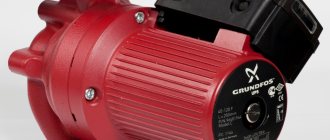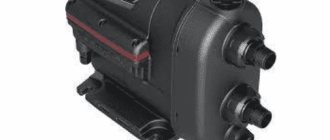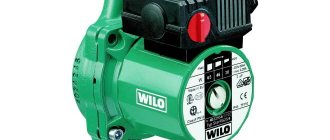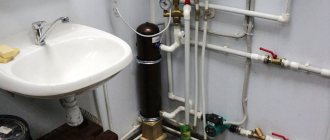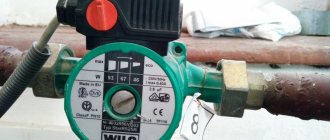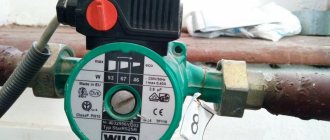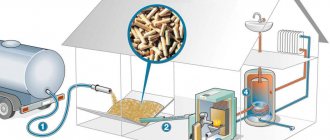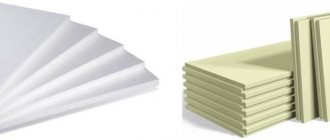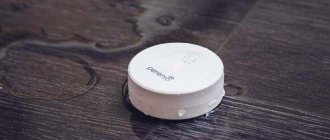A heating system with natural circulation of coolant is a classic, which has several disadvantages. Firstly, the low speed of coolant movement, which reduces its temperature in the return circuit. Secondly, uneven distribution of hot water across the radiators. All this reduces the overall heating efficiency.
There is one solution to this problem - install a circulation pump. But which one? Almost all experts agree on one opinion: today you cannot find a better pump than the Grundfos UPS pump.
Grundfos circulation pump design
Circulation pump with a wet rotor for a home heating system
According to their design, Grundfos heating circulation pumps are divided into two types: with a “wet” and with a “dry” rotor. The first of the designs historically appeared earlier than the second version. Its basis is a body made of cast iron, steel, bronze or aluminum, inside of which a movable rotor is located in an aquatic environment. An impeller is installed on the shaft, causing the working fluid to move.
Pumps with a “dry” rotor began to be produced a little later; the engine and the liquid in them are separated from each other. Due to liquid lubrication, first class pumps are highly reliable. But at the same time, the efficiency of such devices is very small (does not exceed 50 percent).
Units with a “dry” rotor have a slightly higher efficiency indicator (it reaches 70%). These models are most often used for industrial purposes, where operating conditions require pumping large volumes of water. For domestic needs, circulation pumps operating on a “wet” circuit are usually used.
A little history
Grundfos is a company located in Denmark. Its main specialization is circulation pumps. The history of this manufacturer begins in 1945. Danish engineer Paul Du Jensen organized a small production called “Bjerringbro Pressestoberi og Maskinfabrik”. The translation is as follows: injection molding and machining factory in Bjerringbro.
At the very beginning, the engineer developed exclusively pumping equipment. High quality and a non-standard approach to solving many problems regarding the design and dimensions of devices contributed to the fact that the products manufactured by the company began to be in wide demand.
Production was constantly increasing, and the number of users who were interested in the company's products was growing. Until the mid-1960s, the company's name changed constantly. It was only in 1967 that the name Grundfos was approved, which still exists today.
World statistics show that Grundfos heating circulation pumps account for more than 50% of global consumption. First of all, this is due to the high quality of the products. In addition, the company has become an international concern. Plants, workshops, factories - you can find them all over the world. Russia is no exception.
Specifications
The main technical indicators that attention is paid to when choosing a suitable equipment model are:
- graph of the dependence of liquid pressure on the amount of liquid supplied to the system;
- power consumed by the unit’s engine from the network;
- coolant performance;
- permissible temperature of the pumped medium;
- dimensions and weight of the device.
Devices are selected by power depending on the volume of water pumped.
The first of the characteristics allows you to understand what volumes of water are pumped by the pump depending on the pressure developed in the system. The higher this indicator, the less water resource must be passed through the unit to obtain the required pressure. To correctly select a sample of equipment, the operating point must be located under the graph curve. When choosing this indicator, it is advisable to ensure a supply margin of at least 20%. Another parameter is directly related to it - pump performance.
The power taken from the network is determined by the amount of current in the load and the supply voltage (220 or 380 Volts). This parameter is taken into account when selecting current protection devices for power supply circuits and when calculating the cross-section of wires included in the power supply lines. The performance of pumping equipment depends on this value, increasing with its increase.
The dimensions of the purchased sample and its weight are also taken into account when choosing a suitable model. This also applies to the operating conditions of the pump – the minimum and maximum permissible temperature of the pumped medium. The reliability and durability of the purchased sample depends on the correct selection of this indicator.
Blitz tips
- If the sewage submersible pump suddenly begins to consume less current, and its supply has also decreased, then, most likely, the liquid suction area is clogged
When choosing a circuit breaker for the input of power supply lines, it is better to take one that has a Latin D in the marking. This designation shows that this circuit breaker is designed for high starting overloads. For pumps, for example, they can be 3-5 times greater than at steady state.
- When ordering equipment, you should pay attention to the length of the cable that comes with the kit. If possible, it is better to indicate exactly the value that you need. If the cable is short, it can be extended with another one with the same properties. Splicing is done using couplings, or, in extreme cases, PVC tape. It is necessary to carry out this work very carefully, since a short circuit may occur if the twisting is of poor quality.
- High power units - from 4 kW and above, must be switched on through soft starters or through frequency converters (FCs). This equipment prevents hydraulic shocks in the system and also protects the unit from wear. If, in addition to smooth starting, it is also necessary to control the engine frequency, then it is better to choose a frequency converter.
- During maintenance, it is necessary to tighten the screws on the pump power switches every month. Self-unscrewing of screws occurs due to vibration. When contacts rattle, heat is generated in the clamping area, which ultimately leads to burning of the cable ends and possible failure.
- You also need to monitor the flow and passage readings, as well as the current and voltage, every day. Based on these readings, it is sometimes possible to draw conclusions about the correct operation of the unit. For example, if a sewage submersible pump suddenly begins to consume less current, and its supply has also decreased, then, most likely, the liquid suction area is clogged. With a sharp increase in current consumption, we can conclude that the rotation of the impeller is jammed.
- If it is necessary to build wells or sewer pumping stations at a large distance from each other, a telemetry system must be created to control them. It collects data on the operation of these structures in real time and signals accidents.
Advantages and disadvantages
The pump in the floor heating circuit system operates silently - it can be located in the house next to the living rooms.
The advantages of pumps from the Danish manufacturer include:
- high work efficiency;
- reliability of all components and parts;
- low level of own noise;
- versatility of application.
Grundfos pumps are used as part of heating systems and are in demand for organizing hot water supply (DHW) circuits. In addition, they can be installed in “warm floor” systems or in climate control equipment.
The versatility of Grundfos units is also evident in the fact that after purchasing them, the user will be able to work with the following types of coolants:
- water heated to a certain temperature;
- antifreeze that does not contain solid components;
- coolant with the addition of ethylene glycol in a volume of no more than 40 percent.
The advantages of equipment of this class include the operation of the rotor in direct contact with the coolant; it is separated from the other components by a metal cup made of stainless steel. In addition, in these models the inlet and outlet pipes are located at the same level, which ensures quiet operation of the entire unit. The significant advantages of products from the Danish manufacturer include:
- optimal ratio of declared price and quality;
- high energy efficiency indicators;
- a large selection of models capable of satisfying the most demanding customer;
- long service life and developed technical support system.
Characteristic disadvantages of Grundfos pumps are the relatively high price per unit of goods (from 6,500 rubles) and the absence of a cable for connecting to the electrical network.
Key characteristics of Grundfos circulation models
Let's look at the Grundfos circulation pump models on the market today.
Magna
The devices presented in this series are designed to ensure the circulation of coolant in heating systems with variable flow. You can place the device anywhere, which will allow you to optimize energy costs.
The main task performed by the pump of this series is the regulation of water circulation parameters. It is for this function that the design of the unit with its controls is intended. It is also necessary to take into account how well the pump parameters correspond to the communication requirements.
Due to the pressure of 16 bar, Grundfos Magna pumps can be used in large houses with a long circuit length. Users note and note the benefits of the Magna line pump indication system, which in some versions is represented by several light warning fields.
Twin circulation pumps GRUNDFOS MAGNA3 D 32-80
UPS
This series is represented by three-speed models, which are available in two main modifications - 50 and 60 Hz. The UPS 100 line includes over 25 models of circulation pumps, the price of which starts from 6,000 rubles and ends at 40,000 rubles.
The Grundfos UPS 100 series features glandless rotor circulation pumps. In the design of such units, the working elements and the engine are located in one housing, while the rotation shaft and the impeller fixed on it are isolated from the pumped working medium.
Thanks to this design, it is possible to use only two sealing glands, without a mechanical seal, due to which the unit design is simpler and at the same time reliable. All pump models are equipped with ceramic bearings, which have a long service life.
During the operation of the pump, they are lubricated by the pumped liquid. In addition to heating systems, such devices can be installed in the following areas:
- industrial heating and water pumping systems;
- heat pump systems;
- underfloor heating systems;
- geothermal heating;
- heat recovery systems;
- air conditioning;
- refrigeration units.
In addition to the operational advantages of these devices, it is worth noting their high performance, efficiency reaches 80%. The units are distinguished by their reliability, maintainability of design, and long service life. Another important advantage is the ability to operate in three speed modes, due to which you can configure the pump to any operating mode.
Grundfos UPS circulation pump design
The advantages of the Grundfos UPS 100 series pumps include:
- simple electrical connection;
- no need for additional electrical protection. This is due to the fact that current-resistant interlocking motor windings are used here;
- hollow shaft design, through a hole in it air escapes from the chamber;
- no maintenance required.
The downside is the fairly high noise level during operation of the device (only models with a dry rotor do not produce any distracting sounds) and the high cost. However, due to the high reliability that characterizes the design, its price is absolutely justified.
As already noted, the Grundfos company presents more than 25 models of circulation pumps in the UPS 100 line. Let's look at the most popular modifications:
- Grundfos UPS 25-40 (7,000 rubles);
- Grundfos UPS 32-100 (35,000 rubles);
- Grundfos UPS 40-50F (27,000 rubles);
- Grundfos UPS 20-60 130 (10,000 rubles).
How to calculate the power of a circulation pump for heating and hot water supply?
The Grundfos UPS 25-40 circulation pump is considered the most affordable. This is a small unit, which is characterized by economical energy consumption and makes virtually no noise during operation. Such a pump is a device with a dry rotor, in which the rotor and the motor are not in contact with the working fluid.
The unit has three fixed circulation speeds, which can be switched using a lever located on the terminal box. Thanks to the built-in automation, you can set any operating mode - continuous, by timer, or based on the characteristics of the coolant.
The main technical characteristics of Grundfos UPS 25-40 are as follows:
- power is 25/38/45 W;
- operating pressure reaches up to 10 Bar;
- temperature of the pumped liquid -25+100°C;
- operating flow is 1.6 m³/hour;
- pressure reaches up to 4 m;
- threaded connection standard - G 1 ½.
The circulation pump UPS 25-60 and UPS 20-60 are considered more functional models. Such units, in addition to heating systems, can be used in hot water supply, cooling and air conditioning systems. The models are intended for pipelines with a stable flow rate of the working medium, the pressure of which is no more than 10 Bar, and the hydrostatic head is 1.62 m. In the UPS 20-60 pump, the nominal flow rate is increased to 2.3 m³/hour.
The body of the described models is made of cast iron, the impeller is made of a corrosion-resistant composite alloy. The installation length of the pump is 130 mm.
You can buy a UPS 25-60 circulation pump with nuts for 7,000 rubles. The unit has a simple and reliable design, its quality meets high German standards. The device can operate at three speeds, at which a shaft made of ceramic, as well as bearings, can rotate. The power of the described circulation pump is 60 W, productivity is 71 l/min.
The Grundfos UPS 25-80 model is classified as expensive, its price is 13,000 rubles. Such equipment is used to circulate hot and cold water. The case is small, so you can mount it anywhere.
The structure is made of cast iron, the impeller is made of heat-resistant composite material, which contributes to the high anti-corrosion properties of the unit. Such devices can be used for single-pipe and two-pipe heating systems. The circulation pump Grundfos UPS 25-80 has a power of 165 W. The productivity of the unit is 125.25 l/min. The lifting height is 8 m. The maximum liquid temperature is 110°C. The pressure is 10 atm.
Recommendations for choosing UPS series circulation pumps
The most important factor on the basis of which a circulation pump is selected is the flow rate of the heating system. It is based on the flow rate that the required pump capacity is determined - the volume of water that it must drive through the circuit for one hour.
In the table we present the main parameters of circulation pumps series 100 (with nuts) UPS.
| Grundfos circulation pump name | Main settings |
| UPS 25-40 | 1*220 V, thread 1, capacity - 2.93 m³/hour |
| UPS 25-60 | 1*220 V, thread 1, capacity 3.80 m³/hour |
| UPS 32-40 | 1*220 V, thread 1 ¼, capacity 2.92 m³/hour |
| UPS 32-60 | 1*220 V, thread 1 ¼, capacity 3.72 m³/hour |
| UPS 32-80 | 1*220 V, thread 1 ¼, capacity 10.40 m³/hour |
Alpha
Distinctive features of the Grundfos Alpha circulation pump are its ability to work with climate control equipment. The power of the units is based on classic circulation pumps. The most popular models: Grundfos Alpha2 L 25 60, Grundfos Alpha2 L 25 40.
In the basic configuration, Grundfos Alpha provides a throughput of 3 m³/hour, and the equipment pressure reaches 6 m. The advantage of the models is the temperature of the pumped liquid, which can vary from 2 to 110°C.
The most modern modifications are characterized by the unique ability to automatically perform settings. All you have to do is place the pump in the communication circuit, and it will then calculate the appropriate operating parameters.
Features of choice
The size of the union nut depends on the diameter of the connected pipes.
When choosing the right sample of pumping equipment from Grundfos, much attention is paid to the diameter of the union nuts. It is selected depending on the size of the pipe prepared for installation in the heating system:
- if a polypropylene pipe with standard sizes of 20, 25 mm is used, nuts with a diameter of 25 mm are suitable for installation;
- when using pipes of larger diameter (or steel blanks from 25 mm and above), it makes sense to purchase equipment designed for the use of union nuts with an internal diameter of 32 mm.
If the listed requirements are met, no serious problems will arise when installing the equipment if you follow the instructions.
How to choose the right pump
When choosing pumping equipment, you need to take into account the parameters of both the equipment itself and the heating circuit. If you make a mistake, the efficiency of the device will noticeably decrease, that is, money will be “thrown down the drain.”
When choosing, the following parameters should be taken into account:
- size of heated area;
- indoor temperature;
- functionality;
- temperature difference between supply and return;
- pressure;
- network characteristics;
- coolant quality.
If the choice is made correctly, taking into account all the requirements, the room will always have a comfortable temperature. When choosing power, you need to take into account the volume of the room and the indicators to which the coolant in the system should be heated. There are many calculation formulas for determining the required pump characteristics.
Carrying out calculations taking into account average indicators:
- In order to find out how productive the unit is, temperature differences are taken into account - from +30 to +35 °C. The boiler power must be divided by the resulting figure, and the result will show the consumption, that is, productivity.
- 0.6 m of pressure is enough for a pipe 10 m long. For each model, this indicator is regulated and indicated in the passport.
- Heating pipes must have the same diameter as the pipes of the connected equipment. Using one pump, up to 80 meters of circuit can be pumped.
The temperature of the pumped coolant must be taken into account. Pumps installed in heating systems operate with liquid that heats up to +110 °C.
If the circulation circuit is long and the pipes have a large cross-section, then a more powerful installation will be needed. Again, increased power is required if not water, but another, more viscous liquid is used as the coolant.
Modern pumps have a protection class of IP44. This indicates that foreign objects larger than 1 mm have entered the device and water splashes are excluded.
Pump energy efficiency
Well-known European manufacturers of pumping equipment have made great strides in optimizing energy consumption, introducing several wet rotor models to the market. This was achieved through the use of modern DC electric motors controlled by a controller. Such models belong to class “A” equipment, which is considered the most effective in terms of minimizing energy losses - their consumption does not exceed 0.09-1.3 kW).
Grundfos specialists have developed a whole series of energy-saving pumps under the names ALPHA2 and MAGNA3. The former are distinguished by simple functionality and are intended for use in heating and hot water systems of private houses. Models of the second type have the AUTOAdapt function, which allows you to automatically set the optimal power consumption mode. Their capabilities meet modern requirements for the efficiency and performance of equipment in this class. They are designed for use in heating systems of private homes and industrial enterprises.
Review of other models
Grundfos offers two more models:
- Magna.
- Alpha.
Magna
This model has three categories: large pumps, medium and small. For heating systems of private houses, the last two groups are used.
The peculiarity of the model is that it can be used for heating, hot water supply, and air conditioning systems. The device is equipped with a control unit that monitors the temperature and pressure inside the heating system. Low power pumps can be installed on heated floors.
Alpha
This is an innovative solution that allows you to move away from solving problems associated not only with manual configuration, but also with automatic ones. So to speak, this is a “smart pump”. The pump installed in the heating system of the house decides on the basis of which mode it will operate. And be sure that he will choose the best option. This means an even distribution of heat throughout all rooms, plus good fuel and electricity savings.
If for some reason changes occur in the heating, the device itself adapts to them. In this case, you can set the pump certain mode settings. For example, reduce fuel consumption at night or during periods of time when no one is in the house. Plus, a unit is installed in the electricity supply system, which is responsible for converting the frequency of the current.
Operating modes
A modern recirculation pump for heating is a multifunctional device. Various samples of this equipment are capable of operating in the modes indicated in the passport, including “fixed speed”. All of them are equipped with a synchronous motor, the operation of which is controlled by a built-in processor. During operation of the unit, the control unit records the following main parameters:
- current strength;
- rotor speed;
- temperature in the working area and others.
Its presence allows you to adapt to a specific heating network with optimal energy consumption.
Do-it-yourself pump disassembly
If repairs are necessary, the equipment must be taken to a service center if the device is under warranty.
Any user who has thoroughly studied the design can disassemble a purchased sample of pumping equipment if desired. The need for this often arises when it is necessary to repair or overhaul it with the replacement of worn parts. After complete disassembly, the main working components of the mechanism are inspected and then checked for wear.
The main attention is paid to examining the condition of the “wet” rotor. It should be removed and replaced with a new part in the presence of a repair specialist who can supervise this difficult operation.
